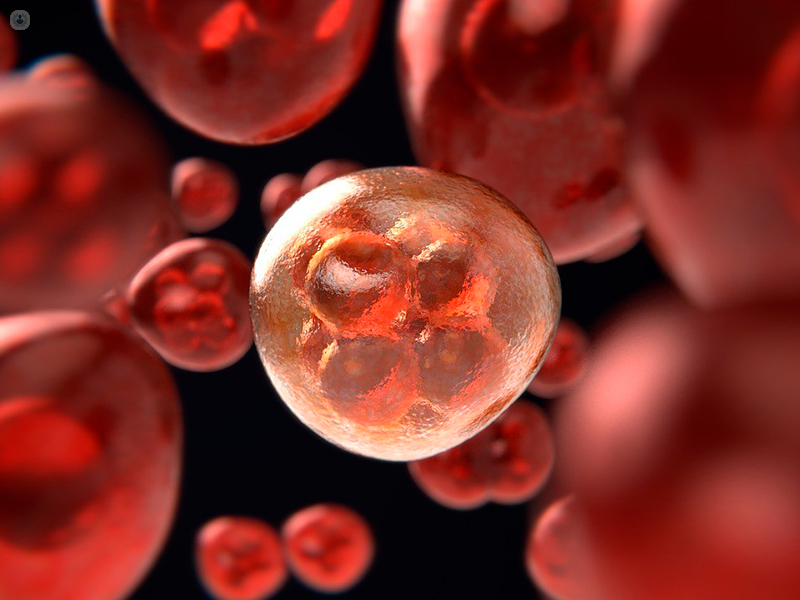How do biological therapies work?
Written by:Regenerative medicine – medicine which helps the body to heal itself – is a rapidly-developing field. In the UK, you can find qualified specialists offering biological therapies such as platelet-rich plasma, scaffolding and tissue bio-glue, all of which aid the healing process in different ways.
We interviewed leading consultant in regenerative medicine Professor Paul Lee to find out how far the technology has progressed in recent years, how these different therapies work, and how often they can be used.

How far have biological therapies evolved in regenerative medicine?
Over the past few years, biological regenerative therapy in musculoskeletal conditions has come on in leaps and bounds.
A very popular treatment of biological therapy is platelet-rich plasma (PRP). With current technology, it is now possible to process blood in a clinic room in a completely sterile environment with a specialist gel separator which will ensure the quality of the plasma. Compared to a few years ago, with older technology which only worked in the lab or with heavy machinery, a current state-of-the-art PRP system is certainly a good example of biological treatment in regenerative medicine in MSK conditions.
In terms of cartilage regeneration, the National Institute of Clinical Excellence (NICE) has approved the use of cartilage cell therapy. This cell therapy has been ongoing for many years in Europe and around the world. The results are excellent, although over the past 10 years the use of cartilage cell therapy has been limited in the UK. With this new guidance from the NICE group, we can continue to build on the international success of cartilage cell therapy. The latest technique that we offer in MSK Doctors in Harley Street means we are able to provide cartilage cell therapy in a single treatment. We term this S.T.A.C.i. With this therapy, only one treatment is needed and the cartilage will regenerate with very good results.
Another biological regenerative therapy has also become very popular in regrowing bone or fracture healing. There are many treatment options now available to enhance the biological recovery of a human being. Our understanding of the biological response to bone healing, fracture healing or cartilage healing has improved greatly. Based on this knowledge, we will be able to apply biological approaches to the human body much better.
What are blood-derived biomaterials, and are there different types?
There are many different types of blood-derived biomaterial.
Platelet-rich plasma
The most common biomaterial that we see used in clinic is platelet-rich plasma. There are many different ways to process platelet-rich plasma and the quality of the platelet-rich plasma varies between clinics and between devices. Some clinics are still using the first generation device and currently at MSK doctors we are using the 5th generation device, with the 6th generation platelet-rich plasma device currently in research and development.
With the newer platelet-rich plasma device, we will have more control over the quality of the platelet-rich plasma that we produce, as well as the way that we filter the blood product. More importantly is the stability: every time we improve our technique we manage to reduce a step in the preparation process, and therefore reduce the chance for error.
There are 10 randomised controlled trials (RCT) which show that platelet-rich plasma is effective in the treatment of knee osteoarthritis, and certainly there are many trials to suggest that platelet-rich plasma can be very useful in the treatment of tendon and ligament injuries.
Tissue bio-glue
Another type of blood-derived product that we can use is tissue bio-glue, which is derived from human blood. Instead of taking the platelet, we can activate the platelet and produce a glue-like substance from the thrombin and the fibrin within the blood. Of course, the balance of the activator and the time taken to filter is essential with this product. Essentially, we can now produce a tissue bio-glue that is able to help and augment the repair.
I am sure in the not too distant future we will be able to produce a tissue bio-glue that is strong enough to hold tissues together.
Platelet scaffolding
Another really exciting blood product that has become more available recently is a platelet scaffold for cell regeneration, which is used very commonly in cartilage repair as well as wound healing. By processing the blood in a specified way, we are now able to produce a specific scaffold that can form the base and the foundation for cell therapy. With this specific scaffold that is produced from your own blood, it will further enhance our ability to perform cell therapy.
There are many exciting developments within the field of blood-derived biomaterials and the landscape is changing rapidly. It is important to keep up to date and have the best advice when choosing to use these products, and I would suggest that patients consult with a qualified regenerative medicine doctor.
How are these materials different to one another?
It depends on where the blood-derived materials are used. They can either be given through injection or they can be given as a surgical procedure.
Usually, with an injection we would guide it by ultrasound or perhaps sometimes by a direct needle camera. We are proud to offer our patients in 108 Harley Street this cutting edge medical technique with a needle camera to help guide our treatment for bone and joint injury.
With cell therapy, tissue bio-glue scaffolding can be delivered with an open or a keyhole procedure. It depends on the size and the location of the defect of the problem. Each case is different and we must assess an injury on a case-by-case basis.
How often are they required?
Biological therapies within the body depend on the reason why we are treating the condition. There are different beliefs and different protocols out there. Essentially, we would need to deliver this active biological ingredient to an injury site or to a site that we want to promote healing.
In my practice, I usually offer the patient a single treatment with the latest generation of biotechnology. If this single treatment works, the problem will be treated and the body has healed, therefore the patient does not need a further injection.
If the treatment does not work at all and the patient does not have any positive effects, this means that the biological treatment has not been given successfully. At that point I would either change to a different method of biological treatment or use a more traditional medical therapy.
However, if the patient has partially responded with a 20% or more improvement, at that time it is worth having further treatment with the same product because the body has given a positive response, and by getting a further injection we will be able to complete the healing process.
However, it is different if we are using this biological agent to supplement our cell therapy, because at that point our cell therapy process is going to be used as an adjunct and also something to augment cell survival. At that point I would repeat this injection every two weeks, a total of five times. There are different protocols out there, and it depends on the machine that we use and the logic behind the treatment. Each treatment is very different.
How do these biomaterials actually work?
It depends on the nature of the injury and the nature of what we would like these bioactive materials to do – the way they work is very different.
Sometimes, these materials can provide a scaffold or a foundation for our body to heal and for the cells to grow. Sometimes, these products are given to produce and promote the growth factors around the injured site. Sometimes, these biological products deliberately try to induce an inflammatory response within the host's body.
The treatment of using a platelet-rich plasma is very complex. For example, there is platelet-rich plasma, platelet poor plasma, leukocyte-rich plasma, leukocyte-poor plasma, leukocyte-rich platelet poor plasma, leukocyte-rich, platelet-rich plasma. These are just the tip of the iceberg, as there are different components of the cells that we can activate and different components of the blood itself we can isolate to use for treatment.
Ultimately, the biomaterial that we produce is to help the body to repair, augment, and regenerate. It is a big step forward in modern medicine – we are finally figuring out how to guide and allow our body to heal ourselves.


